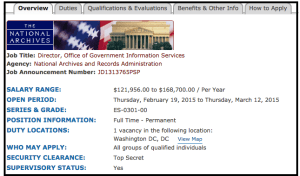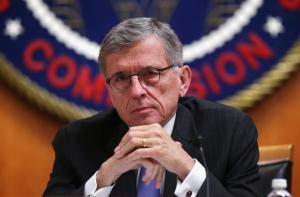OGIS Director Vacancy Announcement Finally Posted, the Difference Between Fee Categories and Waivers, and Much More: FRINFORMSUM 2/26/2015
The National Security Archive is pleased that the vacancy announcement for the director position at the Office of Government Information Services has finally been posted. The position, which heads the small federal office responsible for providing FOIA mediation and compliance services for the entire federal government, had been left unfilled and without a call for applicants since Miriam Nisbet retired at the end of November. Archive FOIA Project Director Nate Jones noted his “extreme concern” that the FOIA watchdog remained director-less at the most recent FOIA Advisory Committee meeting. The announcement is open until March 12, 2015, after which point OGIS will hopefully be able to return to carrying out its pivotal duties at full capacity.
A recent posting by Amy Bennett on OGIS’ blog, The FOIA Ombudsman, provides a great refresher on the difference between FOIA fee categories and fee waivers. The article contains a useful chart that breaks down the different requester categories and their associated fees. The key takeaway from this posting is that requesters should make every effort to obtain a “favorable fee category” – like news media or educational – rather than seek a fee waiver, which demands “a much higher threshold for consideration than a fee category” (in FY2013 fee waivers were granted to less than one per cent of FOIA requesters!). The OGIS posting misses, however, that, pursuant to Section 6(b) of the OPEN Government Act of 2007, agencies in most cases are not allowed to charge non-commercial FOIA requesters “search fees, or, if applicable, duplication fees” if the agency misses the FOIA’s statutory twenty-day response deadline.1

Handier fee chart that says what agencies can charge which requesters if they miss the 20-day deadline.
McClatchy News obtained a Pentagon Inspector General (IG) report through the FOIA that “underscores the problem that intelligence and defense workers face in bringing malfeasance to the surface.” The Pentagon IG investigated former National Security Agency (NSA) employee and whistleblower Thomas Drake’s claims of agency retaliation in the wake of his leak of classified information on surveillance programs. Drake was charged in 2010 under the Espionage Act with 10 felony counts of unlawful retention of classified information, only to have all charges dropped a year later, but not until his career had been torpedoed. Drake claims he was subjected to a decade’s worth of agency retaliation, but the IG report inexplicably only investigated two, “before finding no evidence of retaliation.”
A FOIA request filed by Greenpeace has won the release of documents showing Harvard-Smithsonian Center for Astrophysics scientist Wei-Hock Soon, one of the most frequently cited scientists claiming that greenhouse gas emissions do not contribute to global warming, has received $1.2 million in funding from the fossil fuel industry over the last decade. In that time Soon has regularly avoided citing the conflict of interest in his scientific papers, appearing to violate “ethical guidelines of the journals that published his work” in at least eight cases. The documents show Soon described many of these papers, as well as his Congressional testimony, as “deliverables” when communicating with his corporate sponsors.
Several weeks ago Congressman Jason Chaffetz “reviewed heavily redacted emails and other documents VICE News” obtained in response to a FOIA request, ultimately calling a House Committee on Oversight and Government Reform hearing over what he found. The documents show administration officials communicating with Federal Communications Commission (FCC) chair Tom Wheeler about President Obama’s net neutrality policy.
In responding to VICE’s FOIA request, the FCC, in what the agency said was strict adherence to DOJ guidelines mandating agencies don’t unilaterally declassify documents concerning other agencies, consulted with the White House about whether or not the emails between the administration and the agency should be released. Archive FOIA Project Director Nate Jones notes the FCC’s understanding of the law is a “bit off,” as the White House is not a federal agency, and that the FCC was granting the White House “a political privilege” by giving them the opportunity to review the emails. Jones further notes, “FCC FOIA officers are well trained as to what information may be withheld from requests made under the Freedom of Information Act,” going on to say, “Offering White House political hands (who are not trained in FOIA) another, un-required crack at censoring a FOIA request is bad FOIA policy and a poor demonstration of open government.”
The FBI is claiming, with Department of Justice (DOJ) support, that it cannot find the drone privacy impact assessments that it fully redacted in response to a FOIA request six months ago under the “withhold it because you want to” b(5) exemption. MuckRock’s Shawn Musgrave notes the organization initially filed the FOIA for the privacy assessments because “Federal agencies must conduct a privacy impact assessment prior to deploying any technology that collects personal information, courtesy of the E-Government Act of 2002.” Since the FBI has been flying drones since at least 2005, the privacy assessments should address “what information is being collected and why, how it will be used, who will be able to access it, and other basic details.” When the assessments were withheld last year pursuant to b(5), MuckRock filed further FOIA requests for the assessments and documents concerning why they weren’t made public per proper procedure, only to be informed that “the Justice Department confirmed that neither the FBI nor OPCL had been able to find anything despite ‘an adequate, reasonable search for such records.’” After the story of the now-missing privacy assessments broke, the DOJ, in a remarkable instance of “who’s on first,” told MuckRock that “The questions you raised are best addressed through FOIA, and it is my understanding that you sought similar information already through our FOIA office.”
The Privacy and Civil Liberties Oversight Board (PCLOB) recently published a chart “on how U.S. intelligence agencies use a Reagan-era executive order [12333] to collect Americans’ private information,” showing most agency guidelines are woefully outdated. “Most agencies have not revisited their handling of data collection since the early 2000s, and in some cases not since the 1980s.” The chart shows that while the DOD and FBI reevaluated their internal guidelines in 2008, others haven’t in decades, and “the Homeland Security Department, Treasury Department and United States Coast Guard don’t even have 12333-specific rules.”
A robbery trial in Florida, in which the “defense team detected investigators’ use of a secret surveillance tool” resulting in a plea bargain, is drawing attention to police’s increasing reliance on sophisticated surveillance tools. The judge ordered the government to disclose the device – a cell tower simulator designed to capture cell phone signals to pinpoint a suspect’s location – after it was discovered; the state chose to offer the plea bargain instead. According to the Washington Post, the Florida case “is emblematic of the growing, but hidden, use by local law enforcement of a sophisticated surveillance technology borrowed from the national security world. It shows how a gag order imposed by the FBI — on grounds that discussing the device’s operation would compromise its effectiveness — has left judges, the public and criminal defendants in the dark on how the tool works.”
Documents posted for the first time in a collaboration between the National Security Archive and VICE News provide insight into the U.S. government’s relationship with arms dealer Sarkis Soghanalian, whose larger-than-life deals were so well known that he was inspiration for Nicholas Cage’s character Yuri Orlov in the 2005 film, Lord of War. Check out our top 10 “Merchant of Death” documents here.

Celebrated Navy scientist Dr. John P. Craven in 1993. Photo credit: William J. Broad/The New York Times
This week’s #tbt document picks are chosen with the recent death of celebrated Navy scientist John P. Craven in mind. Craven played an important role in the development of Polaris, the first ICBM to be launched from a submarine, and was allegedly involved in the Hughes Glomar Explorer’s efforts to salvage a Soviet submarine that sunk off the coast of Hawaii. Today’s #tbt picks are a series of six documents from the Digital National Security Archive’s US Nuclear History: Nuclear Arms and Politics in the Missile Age, 1955–1968 collection, and are listed below with a brief description:
Thirty-sixth meeting discusses missile range/weight, reentry vehicle tests, stellar inertial guidance, submarine range and accuracy improvements needed to obtain hard target kill capacity.
Reviews command communications, near-surface operation, and A-3 missile developments.
Ignatius Galantin comments on missile flight tests, and John Craven reports on Polaris submarine tender operations; executive session included.
Forty-third meeting discusses advanced concepts for fleet ballistic missile including slow/quiet submarine, new penetration aids, multiple independently targetable reentry vehicles, stellar inertial guidance, and command, control, and communication improvements.
Reports on fleet ballistic missile problems and developments, including possibility of multiple independently targetable reentry vehicles for Poseidon.
Discussion includes review of A-3 missile development.
Happy FOIA-ing!
1.Pursuant to the 2007 OPEN Government Act, agencies cannot charge requesters search fees if the agency fails to meet the statutory deadlines established in Section 6. The amendment further directs that if an agency misses its deadline for requesters not charged search fees under the FOIA — including news media and educational requesters — by virtue of their fee category, the agency is then not allowed to charge duplication fees. ↩




Trackbacks
Comments are closed.